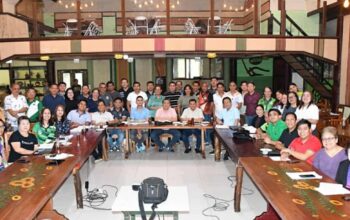By Rey Anthony Chiu
TAGBILARAN CITY, Bohol (PIA) — Milk production volume in Bohol has gone up by 48 percent in 2023.
This was announced by provincial veterinarian Dr. Stella Marie Lapiz at the recent Kapihan sa PIA program.
“From 2022 to 2023, around 48 percent ang increase sa milk production,” announced Lapiz, who is also the Bohol Dairy Production Project implementer.
During the Kapihan sa PIA program, Lapiz explained that although the increase may not be as big, Bohol has attained a consolidated daily dairy production of nearly a thousand liters, which is already higher than the target production.
“As to the market enterprise business plan which the provincial dairy council submitted for funding from government funding institutions in 2022, the funded dairy enterprise project targeted some 15 to 20 percent annual increase in production,” she said.
After the onslaught of Super Typhoon Odette (international name: Rai) in 2021, Lapiz said the herd had to recover from the traumatic experience with farmers needing time to grow the proper forage sources to feed the animals for milking and draft.
In previous years, Bohol has kept the most number of carabaos among the provinces in Central Visayas, which are mostly used as draft animals and for meat.
SURE BUYERS
For this year, Lapiz is confident they will continue to surpass the target in annual milk production.
The dairy enterprise operated by the Bohol Dairy Cooperative (Bodaco) has established institutional buyers, assuring them of sales.
One of these buyers is the Department of Education who sources their milk for their annual feeding program from Bodeco.
The Department of Social Welfare and Development also uses the locally produced milk for their nutritional feeding and supplementation program.
The provincial government in its community-based feeding program has also allocated P10M annually for the purchase of the milk required for the program.
“For these markets alone, Bohol’s daily milk production is still not enough to supply the huge need,” said Lapiz.
She explained that they are using toned milk for the provincial government’s feeding program, which decreases the fats in the milk to ensure that it does not upset the children’s stomachs while providing milk to the most nutrition-deficient children.
DAIRY PRODUCTION
In view of this, the provincial government is encouraging more farmers to explore dairy production as a supplement to their family’s income.
Lapiz said that with proper animal care, deworming, right feeding practices, minerals and vitamin supplements, and good breeding practices, dairy production can be a viable business venture.
“With milk now selling at P70 a liter, having a milking cross-bred carabao means an additional P500 a day,” said Lapiz.
Compared to a native carabao which can only produce 1.5 liters a day after feeding the calf, a cross breed can produce 7 to 12 liters a day.
For a farmer to truly reap the benefits of dairy production, the provincial veterinarian recommends raising 3 to 5 heads of milking carabaos.
“It is still the same work that you do for one or five heads. Build an animal milking shed, plant some forage grasses, dig azolla pond, and add in a mineral block for the livestock,“ she added.
The Kapihan sa PIA in Bohol is a weekly program streamed live on the PIA Bohol Facebook page and and broadcast over DyTR AM every Friday from 4:00 to 5:00 pm. (RAHC/PIA7 Bohol)


